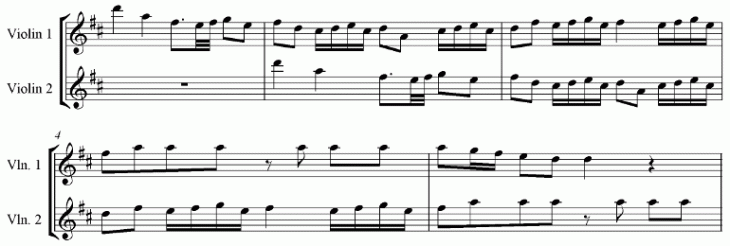- Counterpoint Tutorials -
The Contrapuntal Skeleton - Fourth Species
There is a special dissonance in counterpoint, a dissonance so important, that it has it's own entire species devoted to it. That species is fourth species, and that counterpoint is called the suspension. It is a topic whose intricacies are really outside of the scope of this particular lesson, but, regardless, warrants a brief mention. Our Telemann example lacks suspensions on the rhythmic level of a half note.
Rules for Fourth Species
- All second species rules apply.
- You may now tie half notes across bar lines, creating syncopation.
- Suspensions can now be used.
- It is useful to chain suspensions - it's an effective, powerful technique.
We revert back to second species note values for our fourth species counterpoint. As a result, our counterpoint looks oddly like our previous second counterpoint example score - actually, it's exactly the same. This piece is so fast paced and intricate that suspensions, at least on the half note rhythmic level, would only serve to slow down the quick presto pace of the music. In addition, it's quite difficult to write effective suspensions in a canon. One voice would need to stay still for a very long time to set up the suspension properly. Suspensions can easily be identified through the placement of ties across strong beats, but, as seen below in the original, there are none.
Original
Click here to listen!
Fourth Species, with harmonic interval analysis
Click here to listen!
What's a suspension, and why exactly is it so important?
The suspension holds a powerful position among the renaissance dissonances. It carries incredible emotional impact and strength for one very notable reason - it is the one of the few dissonances (and certainly the most popular) that allows a harmonic dissonance to lie on a strong beat. This reason alone makes this dissonance absolutely impossible to miss in any piece of two-part renaissance counterpoint.
Rules for Suspensions
- Melodic motion: Movement from the preparation to the dissonance is inconsequential, but the movement from dissonance to resolution must move downward and by step if the dissonant voice is above, and upward by step if the dissonant voice is below the held line.
- Beat placement: Suspensions are prepared on a weak beat, execute the dissonance on a strong beat, and resolve on a weak beat.
- Harmonic interval: Suspensions require that the preparation be a consonance of any kind, and that a certain series of intervals to appear in the dissonance and resolution. The allowable pair of intervals is dependent on whether the moving voice is below the sustained note, or above it. Below the moving line, the dissonance must be a perfect 4th followed by a third, also known as a 4-3 suspension. If above, the dissonance must be a 7th or 9th, and the resolution must be a 6th or 8ve, respectively - referred to as 7-6 and 9-8 suspensions. Suspensions between a 2nd and a unison, or 2-1 suspensions (an octave displacement of the 9-8 suspension) are very rare.
Suspension Exercise, with harmonic interval analysis
Click here to listen!
Observe how all the perfect intervals are approached by oblique motion. This is a necessity when working with suspensions - all perfect intervals will be approached by this sort of motion regardless of the suspension's context. Also take note of the contour of this example. It feels very unfinished and unsatisfying. This is due to the general shape - it ascends, tapering off at a very close unison. It started quite differently, with intervals reaching as high as a 10th. If this exercise were to be continued, a conclusion better matching the opening would make this a much more pleasing piece of counterpoint. When writing your own counterpoint, carefully control and plan your contour!
Finally, take a look at the mode of this exercise. It's not D ionian, is it? This bit of music is actually in E dorian. Don't get too caught up in the idea that aeolian and ionian are the only allowable modes. There's a whole range of moods and contrapuntal constructs to explore. Try taking your own counterpoint and transposing it into different modes to hear the effects - just take care to watch out for tritones.
Finally, take a look at the mode of this exercise. It's not D ionian, is it? This bit of music is actually in E dorian. Don't get too caught up in the idea that aeolian and ionian are the only allowable modes. There's a whole range of moods and contrapuntal constructs to explore. Try taking your own counterpoint and transposing it into different modes to hear the effects - just take care to watch out for tritones.



